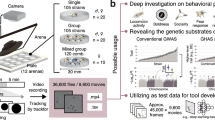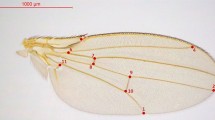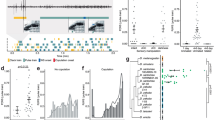Abstract
The interpulse interval of the courtship song of Drosophila melanogaster is a character which may play a significant role in mating success and reproductive isolation. Here we examine the variability of interpulse interval among replicated laboratory strains of D. melanogaster. There is no significant variation among populations of different geographical origin. This suggests that interpulse interval is subject to strong selection, as the populations are known to differ for other characters. One population, however, was sufficiently different to allow a genetic analysis. Reciprocal F1s and backcrosses implied that the variance was predominantly additive and autosomal. Possible sources of selection on interpulse interval are discussed.
Similar content being viewed by others
Article PDF
References
Bennet-Clark, H C, and Ewing, A W. 1969. Pulse interval as a critical parameter in the courtship song of Drosophila melanogaster. Anim Behav, 17, 755–759.
Broadhurst, P L. 1979. The experimental approach to behavioral evolution. In: Royce, J. R. and Mos, L. P. (eds) Theoretical Advances in Behavior Genetics, pp. 43–100. Sijthoff & Noordhoff, Alphen aan den Rijn, The Netherlands.
Butlin, R K. 1994. Genetic variation in mating signals and responses. In: Masters, J., Lambert, D. M. and Spencer, H. (eds) Speciation and the Recognition Concept: Theory and Application. Johns Hopkins University Press, Baltimore, MD. (in press).
Butlin, R K, and Ritchie, M G. 1994. Mating behaviour and speciation. In: Slater, P. J. B. and Halliday, T. R. (eds) Behaviour and Evolution. Cambridge University Press, Cambridge (in press).
Carson, H L, and Templeton, A R. 1984. Genetic revolutions in relation to speciation phenonema: the founding of new populations. Ann Rev Ecol Syst, 15, 97–131.
Charlesworth, B, Coyne, J A, and Barton, N H. 1987. The relative rates of evolution of sex chromosomes and autosomes. Am Nat, 130, 113–146.
Costa, R, Peixoto, A A, Barbujani, G, and Kyriacou, C P. 1992. A latitudinal cline in a Drosophila clock gene. Proc R Soc Lond B, 250, 43–49.
Cowling, D E. 1980. The genetics of Drosophila melanogaster courtship song-diallel analysis. Heredity, 45, 401–403.
Cowling, D E, and Burnet, B. 1981. Courtship song and genetic control of their acoustic characteristics in sibling species of the Drosophila melanogaster subgroup. Anim Behav, 29, 924–935.
Coyne, J A. 1985. Genetic studies of three sibling species of Drosophila with relationship to theories of speciation. Genet Res, 46, 169–192.
Coyne, J A. 1992a. Genetics and speciation. Nature, 355, 511–515.
Coyne, J A. 1992b. Genetics of sexual isolation in females of the Drosophila simulans complex. Genet Res, 60, 25–31.
Ewing, A W. 1969. The genetic basis of sound production in Drosophila pseudoobscura and D. persimilis. Anim Behav, 17, 555–560.
Falconer, D S. 1981. Introduction to Quantitative Genetics, 2nd edn. Longman, London.
Gorczyca, M, and Hall, J C. 1987. The Insectavox, an integrated device for recording and amplifying courtship songs of Drosophila. Dros Inf Serv, 66, 157–160.
Greenacre, M, Ritchie, M G, Byrne, B C, and Kyriacou, C P. 1993. Female song preferance and the period gene of Drosophila melanogaster. Behav Genet, 23, 85–90.
Henderson, N R, and Lambert, D M. 1982. No significant deviation from random mating of worldwide populations of Drosophila melanogaster. Nature, 300, 437–440.
Henry, C S, and Wells, M M. 1990. Geographical variation in the song of Chrysoperla plorabunda (Neuroptera: Chrysopidae) in North America. Ann Entomol Soc Am, 83, 317–325.
Jallon, J-M. 1984. A few chemical words exchanged by Drosophila during courtship and mating. Behav Genet, 14, 441–478.
Kawanishi, M, and Watanabe, T K. 1980. Genetic variations of courtship song of Drosophila melanogaster and D. simulans. Jpn J Genet, 55, 235–240.
Kyriacou, C P, and Hall, J C. 1980. Circadian rhythm mutations in Drosophila melanogaster affect short-term fluctuations in the male's song. Proc Natl Acad Sci USA, 77, 6729–6733.
Kyriacou, C P, and Hall, J C. 1982. The function of courtship song rhythms in Drosophila. Anim Behav, 30, 794–801.
Kyriacou, C P, and Hall, J C. 1986. Interspecific genetic control of courtship song production and reception in Drosophila. Science, 232, 494–497.
Kyriacou, C P, Van Den Berg, M, and Hall, J C. 1990. Courtship song rhythms in wild-type and period mutant Drosophila revisited. Behav Genet, 20, 631–658.
Lachaise, D, Cariou, M-L, David, J R, Lemeunier, F, Tsacas, L, and Ashburner, M. 1988. Historical biogeography of the Drosophila melanogaster species subgroup. Evol Biol, 22, 159–225.
Lambert, D M, and Henderson, N R. 1986. The stability of the specific-mate recognition system of Drosophila melanogaster. Behav Genet, 16, 369–373.
Lande, R. 1981. Models of speciation by sexual selection on polygenic traits. Proc Natl Acad Sci USA, 78, 3721–3725.
Maksymovitch, E, and Verrell, P A. 1993. Divergence of mate recognition systems among conspecific populations of the plethodontid salamander Desmognathus santeetlah. Biol J Linn Soc, 49, 19–29.
Mather, K, and Jinks, J L. 1977. Introduction to Biometrical Genetics, 3rd edn. Chapman and Hall, London.
Mather, K, and Jinks, J L. 1982. Biometrical Genetics, 3rd edn. Chapman and Hall, London.
Paterson, H E H. 1985. The recognition concept of species. In: Vrba, S. (ed.) Species and Speciation, pp. 21–29. Transvaal Museum Monograph No. 4, Transvaal Museum, Pretoria, South Africa.
Petit, C, Kitagawa, O, and Takamura, T. 1976. Mating system between Japanese and French geographic strains of Drosophila melanogaster. Jpn J Genet, 51, 99–108.
Ritchie, M G. 1991. Female preference for ‘song races’ of Ephippiger ephippiger (Orthoptera: Tettigoniidae). Anim Behav, 42, 518–520.
Ritchie, M G, and Kyriacou, C P. 1994. The genetic variability of courtship song in a population of Drosophila melanogaster. Anim Behav (in press).
Scott, D, and Richmond, R C. 1988. A genetic analysis of male-predominant pheromones in Drosophila melanogaster. Genetics, 119, 639–646.
Singh, R S, and Long, A D. 1992. Geographic variation in Drosophila: from molecules to morphology and back. Trends Ecol Evol, 7, 340–345.
Templeton, A R. 1981. Mechanisms of speciation -a population genetics approach. Ann Rev Ecol Syst, 12, 23–48.
Van Den Berg, M J. 1988. Assortative mating in Drosophila melanogaster and among three species of the melanogaster subgroup. Ph.D. Thesis, University of Groningen, The Netherlands.
Von Schilcher, F. 1976. The function of pulse song and sine song in the courtship of Drosophila melanogaster. Anim Behav, 24, 622–625.
Von Schilcher, F. 1989. Have cycles in the song of Drosophila been detected? Trends Neurosci, 12, 311–313.
Welbergen, P, Van Duken, F, Scharloo, W, and Kohler, W. 1992. The genetic basis of reproductive isolation between Drosophila melanogaster and D. simulans. Evolution, 46, 1385–1398.
White, C S, Lambert, D M, and Foster, S P. 1994. Chemical signals and the recognition concept. In: Masters, J., Lambert, D. M. and Spencer, H. (eds) Speciation and the Recognition Concept: Theory and Application, Johns Hopkins University Press, Baltimore, MD. (in press).
Author information
Authors and Affiliations
Rights and permissions
About this article
Cite this article
Ritchie, M., Yate, V. & Kyriacou, C. Genetic variability of the interpulse interval of courtship song among some European populations of Drosophila melanogaster. Heredity 72, 459–464 (1994). https://doi.org/10.1038/hdy.1994.64
Issue date:
DOI: https://doi.org/10.1038/hdy.1994.64
Keywords
This article is cited by
-
Courtship Behavior of Zaprionus indianus (Gupta) (Diptera: Drosophilidae) from Populations Colonizing South America
Neotropical Entomology (2012)
-
Experimental Manipulation of Sexual Selection and the Evolution of Courtship Song in Drosophila pseudoobscura
Behavior Genetics (2005)
-
The Role of Male Courtship Song in Species Recognition in Drosophila montana
Behavior Genetics (2005)
-
Quantitative trait loci affecting a courtship signal in Drosophila melanogaster
Heredity (2002)
-
Polygenic control of a mating signal in Drosophila
Heredity (1996)



